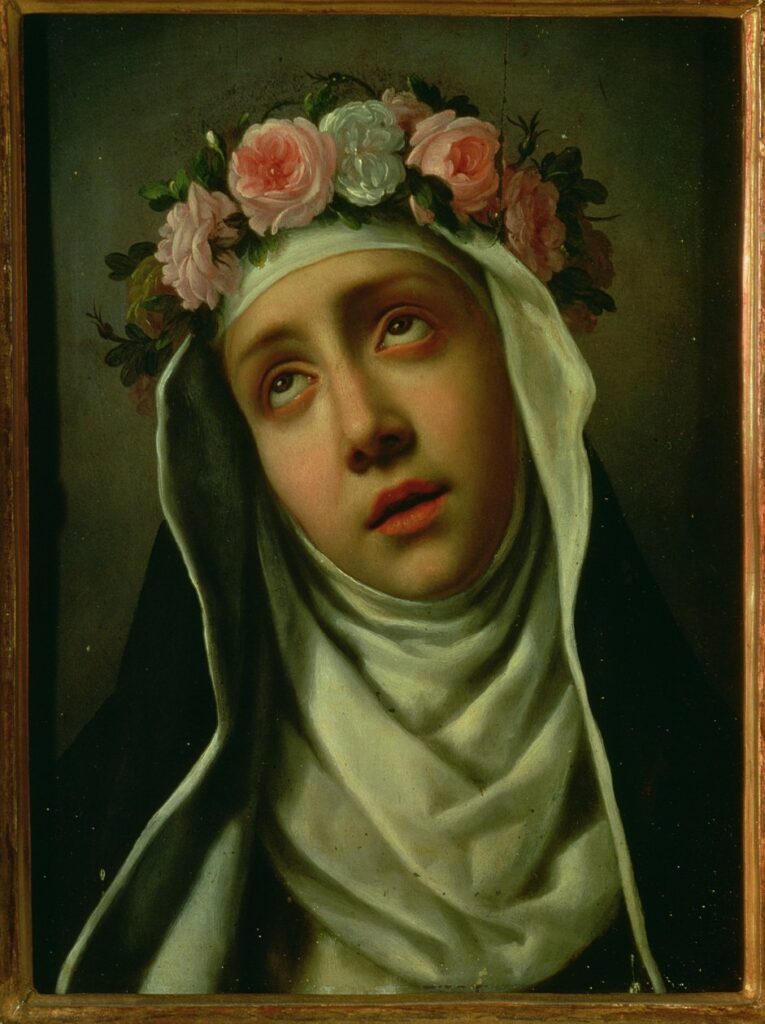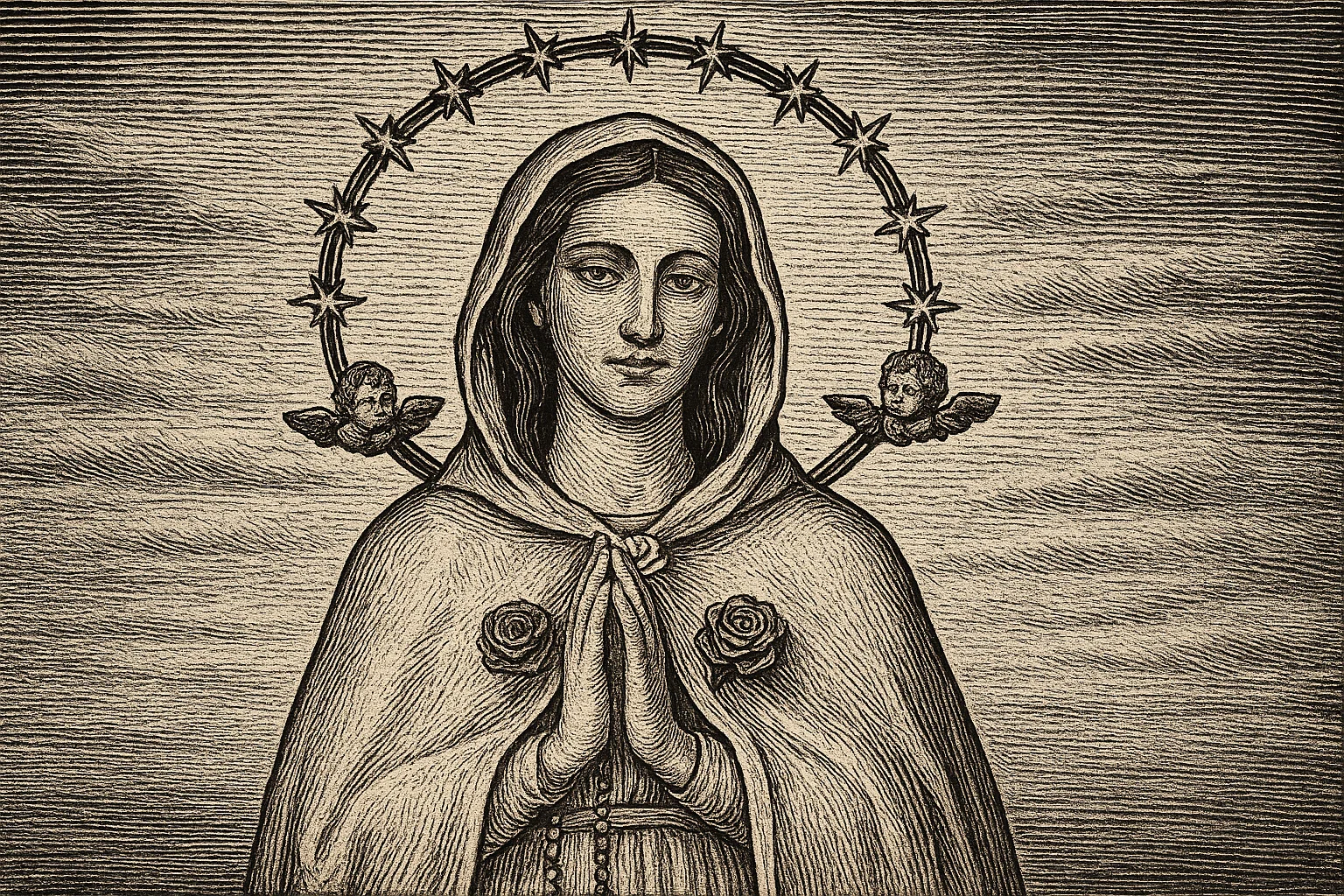There are figures in the Marian tradition who do not occupy the central nave of the cathedral but rather move along its thresholds, bearing mysteries that are neither entirely spoken nor entirely concealed. Among these, the Mystical Rose emerges as a presence at once discreet and impossible to ignore, Her image evoking a silence dense with memory and a perfume that suggests wounds yet to heal. She is a Lady who does not arrive with the certainty of doctrine but appears like a trace left in the air, a pause between words. Her devotion does not fill basilicas, nor does it resound in processions or official liturgies. Instead, She resides at the edge, at the threshold, in the liminal space where memory persists and longing is never quite resolved.
The Mystical Rose is not a mere variant of the Virgin Mary intended for decorative piety. She is, in essence, a veiled Sophia, the feminine aspect of wisdom in exile, whose story is written in petals and whose Eros is not denied, but transformed and suspended. In the tradition of Christian gnosis, Sophia is the one who, moved by desire and memory, falls from the fullness of the divine, Her yearning becoming both fracture and promise. The roses in Mary’s chest are not badges of virtue, but living signs of a cosmic drama. The white rose remembers the state before the fall; the red bears the mark of suffering and distance; the golden rose shimmers with the hope of return, an ache for reintegration that never fully leaves the soul. The body of the Mystical Rose is not untouched, but marked. Her stillness is not absence of life, but the deep, inward gathering of all that was scattered.
The apparition of the Mystical Rose in the twentieth century did not choose the halls of power or convents cloistered in ritual. In 1947, She appeared to Pierina Gilli, a nurse in a provincial Italian hospital. The vision came not to a saint or a mystic in solitude, but to a woman whose daily life unfolded amid the boundary between suffering and care, life and its ceaseless diminishment. The Mystical Rose arrived at the bedside, among bodies awaiting healing or release, and Her message was simple and severe: prayer, penance, and, above all, a renunciation that was not moralistic, but metaphysical. What She called for was the refusal of forgetting, a return to what had been fragmented, a gathering of memory, an honoring of what pain can teach those who do not recoil from it.
To encounter the Rosa Mystica is to face a figure who neither consoles nor admonishes in the way of popular devotion. Instead, She stirs something deeper: the sense that one’s longing for the absolute is itself a form of wounded wisdom, and that even the desire for unity is marked by the pain of having been separated. Her presence is not ornamental, but initiatic. She does not address the faithful as children, nor does She promise miracles without the demand for transformation. The Eros within Her is not extinguished; it remains as a silent tension, an interior fire that does not destroy but purifies. In Her gaze and Her wounds, there is no invitation to resignation, but a call to remember what it means to be exiled from one’s origin, and to turn that exile into a new kind of presence.

Across the threshold of silence, a knowing radiates: creation is the quiet fullness that gathers in the waiting. What appears as wound is also a hidden garden, where memory prepares its return through patient rest and the dignity of pause. Mystery endures not as confusion, but as the gentle turning of the tide, the slow release of shadow into symbol, the rhythm by which everything scattered is invited home. There is recognition in every passage, a movement from hidden abundance through sacred rest, from lunar mystery into the embrace of communal honor. The way is not closed. What remains unspoken is neither lost nor diminished. It endures as a fragrance in the soul, one that is persistent, fertile, alive, awaiting only the touch that remembers.
Perhaps there is something especially paradoxical about the fact that, in Berlin, a city defined by the memory of division, destruction, and the tireless reinvention of its own identity, the Mystical Rose has found a small but enduring altar. In the Catholic church of St. Clemens, in the center of the city, one can find Her image: silent, motionless, bearing the three roses on Her chest, standing at the threshold between worlds. The noise of Berlin, with its restless energy and ceaseless contradictions, does not disturb Her. Inside that church, the atmosphere thickens, and time seems to pause. Here, the Lady who has walked through exile stands witness to those who also wander, reminding all who approach that wisdom is not the privilege of the unmarked, but the destiny of those who carry longing as their deepest truth.
The Mystical Rose is, in this way, a Sophia who refused to forget, a Mary whose desire is not erased by idealization, but rather preserved in the open wound of memory. Her cult does not demand adoration, but remembrance. To approach Her is to consent to the labor of recollecting what has been lost: in history, in spirit, in the body itself. Her roses do not wilt. They remain as signs that Eros and wisdom, when veiled and wounded, can still bloom at the heart of exile, awaiting only the one who dares to recognize their perfume and enter, quietly, into the silence that heals.
